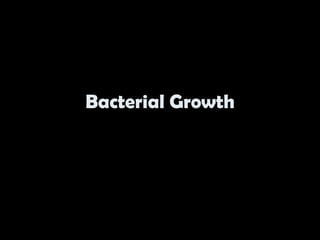
Batecterial growth
- 2. 1) Bacterial growth - is the division of one bacterium into two daughter cells in a process called binary fission 2) Binary Fission – the reproduction of the cell or a one cell divided into two equal parts 3) Lag Phase - bacteria adapt themselves to growth conditions. It is the period where the individual bacteria are maturing and not yet able to divide.
- 3. 4) Log Phase – “exponential phase” growth is very rapid, doubling in numbers in every few minutes 5) Stationary Phase - the growth rate slows as a result of nutrient depletion and accumulation of toxic products. This phase is reached as the bacteria begin to exhaust the resources that are available to them. 6) Death phase- bacteria run out of nutrients and die.
- 4. pH – potential of Hydrogen. A measure of the acidity or alkalinity of a solution, numerically equal to 7 for neutral solutions, increasing with increasing alkalinity and decreasing with increasing acidity. The pH scale commonly in use ranges from 0 to 14.
- 5. 4 Phases of Bacterial Growth
- 6. 6 Conditions Bacteria Multiply
- 7. F - Food Protein foods Carbohydrates
- 8. A - Acidity acidic alkaline 7 • Very acid (below 4.6) will not support the growth of bacteria • pH (4.7 to 9.0 ) is the best for the bacteria to grow and multiply. Meat, milk , fish are in this range. • Disease causing bacteria grow best at the pH 4.6 to 7.0
- 9. Alkaline Foods Acidic Foods Alkaline – Fruits,vegetables Acidic - corn, meat, beans, Very Alkaline - Bananas fish, fowl, grains, coffee, plums, prunes, distilled Chocolate, mineral water water, potatoes, spinach, water melon Very acidic – Eggs, liver, gravy, wine, yogurt, sour cream, fermented foods and aged cheeses
- 10. T - Temperature • Temperature Danger Zone - temp. range 41F-140F (5C-60C). Food borne bacteria grow and reproduce. • Temperature Abuse –foods that have not been to a safe temperature or kept at the proper temperature Psychrophilic bacteria – grow within the temperature range of 32F(0C) – 70F (21C) (spoilage organisms)
- 11. • Mesophilic bacteria – grow at temp. 70F(21C) – 110F(43C) • Thermophilic bacteria – grows best above 110F (43 c) Cold foods, must be stored 41F or below Hot foods, must be held at 140F (60C) and above
- 12. T - Time • Under ideal conditions, bacterial cells can double in number every 25 minutes to 30 minutes. • Pathogens starts to multiply in four hours at the Temp. Danger Zone
- 13. O - Oxygen Bacteria differ in their oxygen requirement. Anaerobic bacteria – cannot survive when oxygen is present bec. it is toxic to them. Anaerobic bacteria grow well in vacuum packaged foods or canned foods where oxygen is not available
- 14. Aerobic bacteria – need oxygen to grow Facultative anaerobic bacteria – can grow with or without free oxygen but have a preference Microaerophilic organisms – can survive in a very little amount oxygen,
- 15. M- Moisture Moisture is important factor in bacterial growth. The amount of water available for bacterial activity. Water Activity level – is the measure of the amount of water that is not available for bacterial to grow. ( 0- 10) Potentially hazardous foods (PHF) – foods that have a water activity level of .85 or higher
- 16. TYPES OF FOOD HAZARDS
- 17. Test your knowledge (true / false) 1. Fish that has been properly cooked will be safe to eat 2. Cooking can destroy the toxins. 3. Copper utensils can cause illnesses when used to prepare acidic foods 4. Cleaning products may be stored with packages with foods 5. Most biological toxins found in seafood, plants and mushrooms occur naturally , are not caused by the presence of microorganisms.
- 18. FOODBORNE HAZARDS – refers to biological, chemical, or physical that can cause illness or injury when consumed along with the food. Types of Food borne hazards: 4) Biological Hazards 5) Chemical Hazards 6) Physical Hazards
- 19. 1) Biological Hazards • Biological contaminants – caused by microbial contaminants such as bacteria, viruses, parasites, fungi and biological toxins. pathogens spread mostly by foodhandlers unsanitary facilities and equipment pests
- 20. 3 Types of Biological Toxins 1) Seafood Toxins b) Ciguatera Toxin – fish that have eaten algae containing toxins (amberjack, barracuda, grouper, snapper). Odorless and tasteless cooking do not destroy toxins. c) Scombroid toxin – histamine caused by bacteria, they are time temp abused. ( bluefish, mackarel, swordfish, mahi mahi). d) Shellfish toxin – caused by algae they eat. (mussel, clams, scallops)
- 21. 2. Plant toxins – natural part of plants 3. Fungal Toxins – poisonous mushrooms ***cooking and freezing will not destroy the toxins ***
- 22. 2) Chemical Hazards Caused by chemical substances like toxic metals, pesticides, cleaning products, sanitizers, lubricants Utensils and equipment containing toxic metals ( lead, copper, brass, zinc, antimony and cadmium) – can cause a toxic metal poisoning when combined with acidic foods
- 23. What to do? Store chem. Away from foods, utensils and equipment used for foods Clear labels and stored away from food Measure correctly Wash hands afterwards Wash fresh fruits and vegetables Monitor pest control operators Metal containers – use only NSF and UL labeled
- 24. 3) Physical Hazard • A foreign object that accidentally find its way to the food such as a piece of glass, hair, fingernails, dirt, metal shavings, staple wires
- 25. What to do? Store toothpicks, etc. below food Shields on lights Clean can openers Remove staples, etc. in receiving area away from food Avoid temp equipment fixes that could fall off Use hair restraints No nail polish, jewelry No pencils behind ears Only approved food containers for storage Never re-use single use containers
- 26. Where are the hazards?
